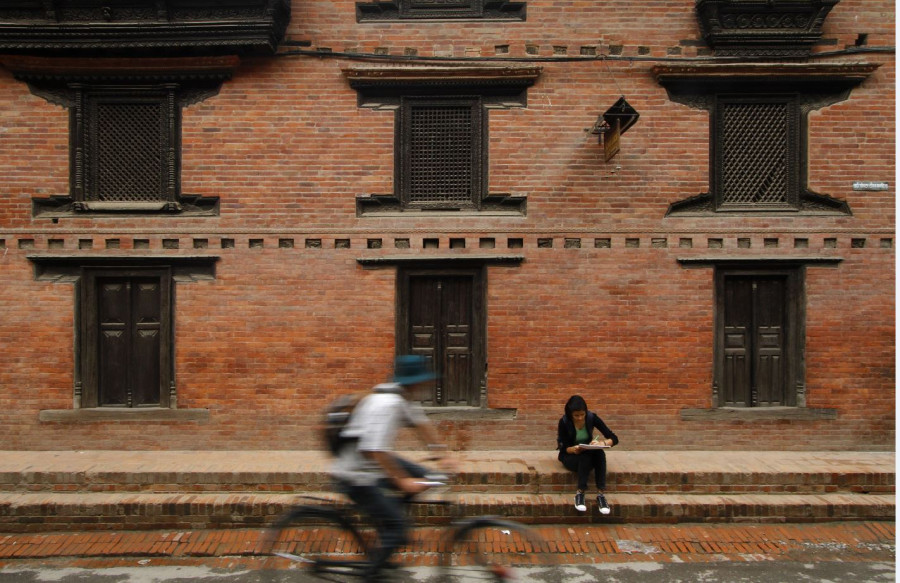Valley
Patan wants to become a cycle city. But can it pull it off?
The city of Patan wants to transform its ancient and historic centre for pedestrians as part of the municipality’s transport master plan. At the heart of the project is an ambitious plan: building a network of cycling lanes.
Arpan Shrestha
The city of Patan wants to transform its ancient and historic centre for pedestrians as part of the municipality’s transport master plan. At the heart of the project is an ambitious plan: building a network of cycling lanes.
The project envisions connecting Patan’s open spaces, river corridors, ancient heritage sites and forgotten trails on the southern rim of Kathmandu Valley with each other. According to Mayor Chiribabu Maharjan, it is a commitment to rectify past blunders and revitalise the city.
“How we plan our city today will decide the future of Patan,” the mayor said in an interview with the Post. “The vehicle-centric development has only resulted in more congestion and air pollution and a loss or absence of footpaths and open spaces. Accidents have killed and injured people.”
But Maharjan’s plan won’t be easy, especially when it comes to implementation as lane enforcement or speed limit remains a daunting challenge. There is bound to be public opposition as well, says the mayor who has already allocated Rs50 million for the preliminary cycle lane with designated cycle stands.
“I anticipate protests. But it’s my job to make the people and our community understand that our problems will only escalate if we do not intervene the fundamentally flawed perception that new and wide roads are a solution,” he said.
Patan’s traffic, which flows in and out of major thoroughfares in Kathmandu, worsens at peak hours, regularly coming to a standstill. Thousands of people are often stuck in traffic for hours on end while on their way from one point to another. Road safety is at its record low, and levels of air pollution peak at hazardous levels across the Valley. All this, Maharjan said, has degraded the quality of life and is a tipping point.
But this will gradually change as the first phase of the municipality transport master plan comes into effect later this month, according to Maharjan, who is working with the Inspector General of Police, Sarbendra Khanal, to bring his experience of pedestrianising Thamel to Patan’s ancient heritage site.
“The roads surrounding the Patan Durbar Square will be a no-vehicle zone, including two-wheelers,” Maharjan said. “But we will allow bicycles.”
The mayor, who claims to have been inspired by cities like Chengdu in China and Vancouver in Canada, said the idea behind the project is to change people’s mindset. “And we want to make them realise that our mode of transportation is directly related to our environment and congestion on the road,” Maharjan said.
According to the city officials, the road stretch beginning from Kupondole to Lagankhel will also have cycling lanes on both sides of the road in the second phase of the municipality’s radical plan to shift the urban mobility from a heavily motorised to a largely non-motorised one.
“It is not a dedicated cycling lane but cycles will get the first priority,” Rakesh Maharjan, an urban planner from the award-winning firm One Line Architects, told the mayor’s task force in a meeting last month at the metropolitan office in Pulchowk.
 An aerial view of Patan Durbar Square, one of the UNESCO World Heritage sites in the Valley. POST FILE PHOTO
An aerial view of Patan Durbar Square, one of the UNESCO World Heritage sites in the Valley. POST FILE PHOTOThe task force, led by planning department’s Rudra Gautam and Nepal Cycle Society, a nonprofit comprising a new generation of urban planners and designers and transport engineers, also reviewed a preliminary map of Patan showing the potential network of cycle lanes and designs of cycle stands.
“We need to get this [cycling lane] started before the end of this fiscal year. We can’t risk this window and we also need to finalise the design and the placement of cycling stands,” Gautam told the group after Maharjan wrapped up the presentation on behalf of the cycle society.
Gautam said they also expect to introduce a new law to prevent cyclists from road accidents. Another metropolitan official moderating the meeting chipped in, “We have to make parking expensive for cars and motorbikes.”
A week before the meeting, Maharjan, along with activist and teacher Amrit Bista, urban planning consultant Dori Nguyen and student Rubin Singh Maharjan had gathered at the mayor’s studio office in Chakupat to review the status of their pilot project of building a preliminary cycle lane in Patan.
“The inverted pyramid mobility first prioritises pedestrians and bicycles followed by public and cargo transport and then the private vehicles. We need to implement this basic principle,” the Patan mayor told the Post. The preliminary network that we are mapping is just the start of a cycle-friendly city and a strategic move to set the course for the future of urban mobility in Patan.”
That urban mobility should be inclusive, environment-friendly, low carbon and economically sustainable are key concepts guiding urban development in cities everywhere, according to New Jersey-based urban planner Upendra Sapkota.
“Mayors and governments are implementing bold policies which put the environment and liveability first. Most cities have already or are soon transforming into pedestrian and cycling zones by intervening their street design,” said Sapkota, who specialises in neighbourhood development and economic development strategies.
The widening and construction of new roads and river corridors in the Kathmandu Valley have made traffic worse, cut off communities, encouraged sprawl and speeding, creating perilous road conditions for pedestrian and bikers. But a new generation of urban planners and transport engineers say Kathmandu Valley and emerging cities across Nepal have an opportunity to leapfrog the 19th- and 20th-century transit systems by adopting proven street designs that put the quality of life at the heart.
“We are not against vehicles—don’t get us wrong—but we have to reverse the wrongs institutionalised by roads built to cater to vehicles only,” said Kiran Joshi, another urban planner who is volunteering with the cycle society. “Decisions made today will decide how mobility will evolve in the next decade.”
Joshi said him and others involved in the cycle society are considering factors such as population density and points of interest, road conditions and route connectivity and the demands of local representatives before coming up with the top routes for cycle lanes in Patan.
According to urban planning consultant Dori Nguyen, who advises the cycle society, transforming a city from an auto frenzy era to one that is green and safe would require funding to design and implement interventions that unify all modes of transit, and revitalise neighbourhoods by making it easy for the public.
“Kathmandu is geographically small and so is its population base. It cannot sustain gigantic infrastructure which is extremely expensive,” she said. “The cost to build the infrastructure for 100 metres of a metro could roughly cover the costs of building an entire network of cycle lanes across Kathmandu.”
Understanding and solving a city’s mobility challenge would also require bold and integrated actions from government authorities, the private sector and the public, but the Patan mayor says this is the turning point and the new constitution grants him the powers to right past mistakes.
“The future can change only if there is a political will. The aim of the municipality transport master plan is to make the road primarily for pedestrians and increase the number of cyclists,” he said.
The mayor’s office has also committed to doubling the funding in the next fiscal year to implement what will be Nepal’s first preliminary network of cycling lanes with designated stands. And no one could be happier than Ratna Shrestha, a dental paramedic who leads the cycle society.
“It has been hard for this team of professionals to come together and volunteer their time and skills to do something this ambitious,” the cycle society president said. “The road has to connect people, not divide or marginalise them.”




 20.12°C Kathmandu
20.12°C Kathmandu










